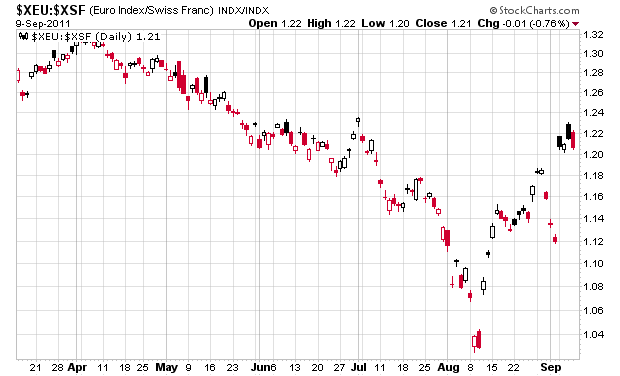I have not been an active writer in the past couple weeks, in part due to taking an extended break, but in part due to the fact that I am trying to await this financial storm and pick a point of maximum negative sentiment, which will be at the point where the perceived risk is the highest, and hence lowest price. My history suggests I am fairly good at picking bottoms, but I do not believe that time is at present. I am sitting at a 75% cash position.
Volatility is very high – in the past month there were many days where the absolute percentage change in the major indicies was greater than 2% – timing the gyrations is an impossible task. Implied volatility on the S&P 500 has also been around 30 to 45%, and the volatility of the volatility has been high. Suffice to say, anybody trading this market will have to have nerves of steel and very well-functioning computer models.
There are a few indications out there that things are worse than what markets are currently pricing in. Right now, we have a Canadian 10-year bond yield trading at 2.21% and the US bond yield at 1.92% – the both of which are lower than the 2008-2009 financial crisis. The bond market is pricing in a financial disaster that is awaiting us.
Remarkably, major US financial firms such as Goldman Sachs, Bank of America, JP Morgan are trading at yearly lows, which suggests that equity markets are banking on something bad happening. It is suggested that most of this is a result of what is happening in the European Union. A very quick proxy for the disruption in the European financial markets is looking at junior bank debt – an example of which is ING Group’s hybrid debt (NYSE: ISG – and take a look at the 5-year chart to see the impact of the 2008-2009 financial crisis). Equity in European banks are also more volatile than the debt securities, e.g. Deutsche Bank (NYSE: DB).
Political analysis is an area that gives me an advantage over the market, but there are two well-known events that have already been somewhat factored into the marketplace: Finland recently elected a new parliament, but the True Finns party basically ran on an election platform of “Don’t bail out the EU” and managed to gain a whopping 15% in representation in parliament. The other event was in Germany, where the existing CSU/CDU government (which has previously been on the side of trying to preserve the Euro and support a bailout of bad soverign debt of some form) has lost significant voter support in their recent batch of local elections against the SDP.
Since there is only a monetary and not political union, it makes it highly unlikely that the European Bank will be able to facilitate any quick fixes to their financial situation, relative to the problems in the USA with the federal reserve. However, the spillover to international financial institutions is continuing to be felt. My guess is that there needs to be a mass liquidation of some sort, similar to what happened in early August when somebody obviously hit the “sell everything” button on their billion dollar portfolio.
The central bank of Switzerland (Swiss National Bank) earlier in September also declared war against all currency speculators with it announcing that it will not tolerate less than a 1.2 Swiss Franc to Euro ratio, citing a gross overvaluation of its currency. Some traders must have received the margin call of the year when you look at this chart:
The Canadian dollar, in relation to all of this and relative to the US dollar, has remained around the 1.00-1.05 ratio against the US dollar. I do not have strong feelings about the Canadian dollar, but I would suspect it will remain vulnerable against US currency, which despite all of the country’s dysfunctionality, remains a short-term safe haven. Since Canada’s economic fortunes are strongly linked to commodity markets, there is vulnerability and correlation to a slowing world economy and commodity pricing – hence, not as diversified as the US currently is.
Are Canadian Banks (TSX: BMO, BNS, CM, RY, TD) vulnerable? You would think with the leverage on their balance sheets (e.g. a very quick look at BNS, you have $20B in tangible common equity leveraged against $560B in tangible assets, or a 1:28 ratio – I realize this is a very elementary analysis that ignores a whole host of other mitigating factors including the fact that consolidated statements are inappropriate for this type of conjecture) that if there is a minor amount of loss that they have to take against these assets (4%) that you are going to wipe out the bank’s equity. The risk-reward for Canadian bank equity seems to be highly skewed towards not being worth the risk.
Generally, forward valuations appear to be extremely attractive, especially in the large cap sector. However, these valuations do not take into consideration the deleveraging that we are seeing and the impact of market psychology when you have a stadium of financial participants that are all trying to reach for the exits at the same time. The easy play seems to be investing in low-P/E, low-P/B companies, but even these entities are going to get trampled if/when the stampede occurs. There no long appears to be any risk-free assets other than cash – and even that has the risk of being whittled away by the significant inflation that is being imparted with quantitative easing and its various forms. The state of world economics at the moment appears to be a game of financial musical chairs where you have a hundred players reaching for eighty seats, and the music is about to end.
In terms of translating this into investment possibilities if/when we see another 2008-2009 style meltdown, I will leave this for another post.


